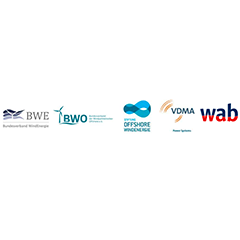- In the first half of 2020, only 219 MW of offshore wind energy was installed in Germany, as of 30 June the total capacity was 7,760 MW
- Industry welcomes long-term planning security with increased expansion targets up to 2040 and calls for an economically efficient remuneration model
- Creation of an incentive system for the market ramp-up of green hydrogen is important
- EU Council Presidency and North Sea Cooperation: Laying the foundation for cross-border offshore wind projects
- Offshore wind energy will make a significant contribution to the “Green Recovery”
Berlin, 17 July 2020 – “Particularly against the background of the low level of new installations, we appreciate that the anchoring of 20 GW offshore wind energy by 2030 and 40 GW by 2040 now creates long-term planning security. With the increased expansion targets, offshore wind energy strengthens climate protection and creates economic development”, the industry organisations BWE, BWO, VDMA, WAB and the German Offshore Wind Energy Foundation comment on the offshore expansion figures published today by Deutsche WindGuard.
As forecast at the beginning of the year, only 32 offshore wind turbines with a capacity of 219 MW were connected to the German grid in the first half of 2020.[1] This figure corresponds to around 11 percent of the installed capacity of 2 GW that the domestic value chain implemented in 2015. According to the current status, 1,501 turbines with a total output of 7,760 MW are thus reliably supplying offshore wind power in Germany. The Federal Government’s expansion target for 2020 has already been achieved in the first half of the year.
“Not least because of the long planning time of offshore wind farms, we have long warned that an expansion gap is imminent. We are now in the middle of it. The challenge now is to keep this expansion gap as small as possible and to strengthen the domestic market for offshore wind energy sustainably and permanently. In addition to anchoring the long-term goals in law, this also includes putting the available areas out to tender as quickly as possible and choosing an economically efficient remuneration system for future offshore wind projects,” the industry organisations explain. The basis for this should be created quickly after the summer break and in dialogue with the industry.




























